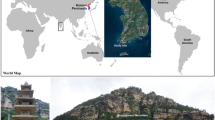Abstract
This study focused on the quantitative deterioration evaluation for the Magoksa temple stone pagoda of the thirteenth century in Korea, based on the deterioration map by precise observation and ultrasonic velocity measurements. The stone pagoda is composed mainly of fine-grained quartz diorite with some granodiorite used in the second story and dew bowl, and the replacement stone for restoration in the basement is biotite granite. The deterioration map and the 2D contour map projecting ultrasonic velocity showed that the most serious deterioration was to the north face of the pagoda, which has about 81.2% deterioration rate and a low velocity range compared with the other directions. Thus, it is required to prepare conservation schemes to reduce deterioration and reinforce the structure. It is also required to carry out ground exploitation for calculation of load carrying strength and ground strength together with continuous structural monitoring. The results will be important for the stable and long-term conservation of the pagoda and will further serve to establish scientific conservation systems of stone cultural heritages in the future.





Similar content being viewed by others
References
Avdelidis NP, Moropoulou A (2004) Application of infrared thermography for the investigation of historic structures. J Cult Herit 5:119–127
Baek SC, Kim YT, Kim HT, Yoon JS, Lee YG (2006) Evaluation of rock uniaxial compressive strength using ultrasonic velocity. J Korean Geotech Environ Soc 7:33–42
Barruol G, Kern H (1996) Seismic anisotropy and shear-wave splitting in lower-crustal and upper-mantle rocks from the Ivrea Zone—experimental and calculated data. Phys Earth Planet Inter 95:175–194
Fitzner B (2004) Documentation and evaluation of stone damage on monuments. In: Proceedings of the 10th international congress on deterioration and conservation of stone, Stockholm, Sweden, pp 677–690
Fitzner B, Heinrichs K (2004) The Bangudae petroglyph in Ulsan, Korea: studies on weathering damage and risk prognosis. Env Geol 46:504–526
Goodman RE (1989) Introduction to rock mechanics. Wiley, New York
Iliev IG (1966) An attempt to measure the degree of weathering of intrusive rocks from their physico-mechanical properties. In: Proceedings of the 1st congress of the international society of rock mechanics, Lisbon, Portugal, vol 1, pp 109–114
Kahraman S (2001) Evaluation of simple methods for assessing the uniaxial compressive strength of rock. Int J Rock Mech Min Sci 38:981–994
Kahraman S (2002) Estimating the direct P-wave velocity value of intact rock from indirect laboratory measurement. Int J Rock Mech Min Sci 39:101–104
Kolsky H (1953) Stress waves in solids. Clarendon, London
Lee CH, Yi JE (2007) Weathering damage evaluation of rock properties in the Bunhwangsa temple stone pagoda, Gyeongju, Republic of Korea. Environ Geol 52:1193–1205
Lee CH, Lee MS, Kim YT, Kim J (2006) Deterioration assessment and conservation of a heavily degraded Korean stone Buddha from the 9th century. Stud Conservat 51:305–316
Lee CH, Jo YH, Chun YG (2009) Establishment of ultrasonic measurement and correlations of direct-indirect method for weathering evaluation of stone cultural heritage. J Conserv Sci 25:233–244
Lee CH, Jo YH, Kim J (2011) Damage evaluation and conservation treatment of the 10th century Korean rock-carved Buddha statues. Environ Earth Sci 64:1–14
Nuzzo L, Calia A, Liberatore D, Masini N, Rizzo E (2010) Integration of ground-penetrating radar, ultrasonic tests and infrared thermography for the analysis of a precious medieval rose window. Adv Geosci 24:69–82
Sharma PK, Singh TN (2008) A correlation between P-wave velocity, impact strength index, slake durability index and uniaxial compressive strength. Bull Eng Geol Environ 67:17–22
Suh M, Song I, Choi H (2002) The structural safety diagnosis of Dabo Pagoda of Bulkuk Temple using analyses of ultrasonic wave velocity. J Korean Geophys Soc 5:199–209
Yasar E, Erdogan Y (2004) Correlating sound velocity with the density, compressive strength and Young’s modulus of carbonate rocks. Int J Rock Mech Min Sci 41:871–875
Acknowledgments
This study, which forms a part of the project, has been achieved with the support of National R&D project, which has been hosted by National Research Institute of Cultural Heritage Administration in Republic of Korea. The authors express sincere gratitude to the anonymous reviewers and the Editor-in-Chief (Dr. James W. LaMoreaux) for critical reading and constructive suggestions of the manuscript.
Author information
Authors and Affiliations
Corresponding author
Rights and permissions
About this article
Cite this article
Jo, Y.H., Lee, C.H. & Chun, Y.G. Material characteristics and deterioration evaluation for the 13th century Korean stone pagoda of Magoksa temple. Environ Earth Sci 66, 915–922 (2012). https://doi.org/10.1007/s12665-011-1301-8
Received:
Accepted:
Published:
Issue Date:
DOI: https://doi.org/10.1007/s12665-011-1301-8




